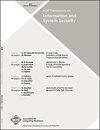工作流授权系统中的可满足性和弹性
Q Engineering
ACM Transactions on Information and System Security
Pub Date : 2010-12-01
DOI:10.1145/1880022.1880034
引用次数: 114
摘要
提出了基于角色和关系的工作流授权访问控制(R2BAC)模型。在R2BAC中,除了用户的角色成员关系外,用户与其他用户的关系还有助于确定是否允许用户执行工作流中的某个步骤。例如,约束可能要求有利益冲突的用户不能执行两个步骤。我们研究了工作流可满足性问题的计算复杂度,即一组用户是否能够完成一个工作流。特别是,我们应用参数化复杂性理论的工具来更好地理解这个问题的复杂性。此外,我们将工作流满意度问题简化为SAT,并应用SAT求解器来解决该问题。实验表明,该算法可以有效地求解合理大小的实例。最后,有时仅仅确保工作流在正常情况下能够完成是不够的。我们研究了工作流授权系统中的弹性问题,即工作流是否可以在多个用户缺席的情况下完成。我们正式定义了工作流系统中的三个弹性级别,并研究了与这些弹性概念相关的计算问题。本文章由计算机程序翻译,如有差异,请以英文原文为准。
Satisfiability and Resiliency in Workflow Authorization Systems
We propose the role-and-relation-based access control (R2BAC) model for workflow authorization systems. In R2BAC, in addition to a user’s role memberships, the user’s relationships with other users help determine whether the user is allowed to perform a certain step in a workflow. For example, a constraint may require that two steps must not be performed by users who have conflicts of interests. We study computational complexity of the workflow satisfiability problem, which asks whether a set of users can complete a workflow. In particular, we apply tools from parameterized complexity theory to better understand the complexities of this problem. Furthermore, we reduce the workflow satisfiability problem to SAT and apply SAT solvers to address the problem. Experiments show that our algorithm can solve instances of reasonable size efficiently. Finally, it is sometimes not enough to ensure that a workflow can be completed in normal situations. We study the resiliency problem in workflow authorization systems, which asks whether a workflow can be completed even if a number of users may be absent. We formally define three levels of resiliency in workflow systems and study computational problems related to these notions of resiliency.
求助全文
通过发布文献求助,成功后即可免费获取论文全文。
去求助
来源期刊

ACM Transactions on Information and System Security
工程技术-计算机:信息系统
CiteScore
4.50
自引率
0.00%
发文量
0
审稿时长
3.3 months
期刊介绍:
ISSEC is a scholarly, scientific journal that publishes original research papers in all areas of information and system security, including technologies, systems, applications, and policies.
 求助内容:
求助内容: 应助结果提醒方式:
应助结果提醒方式:


